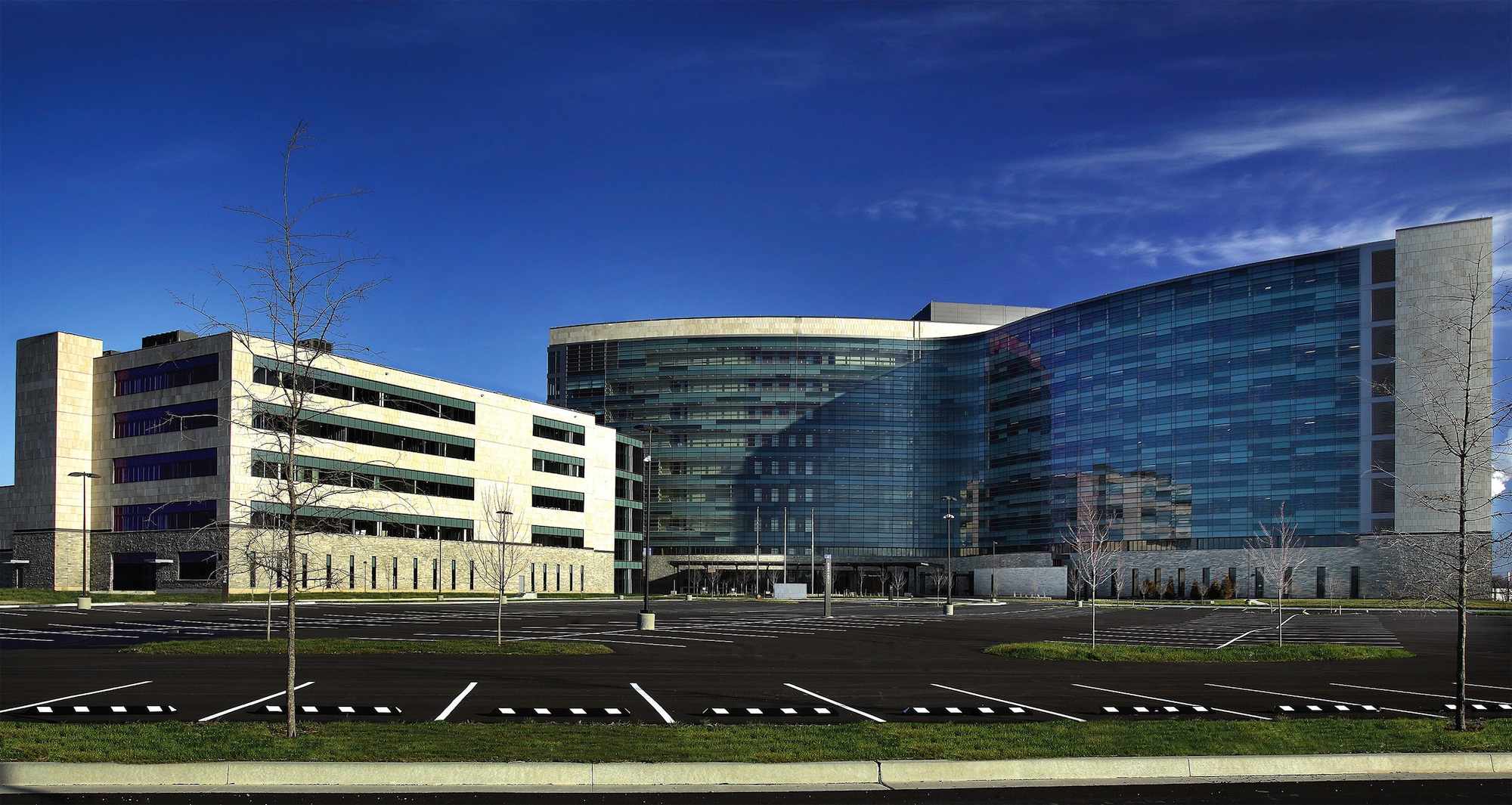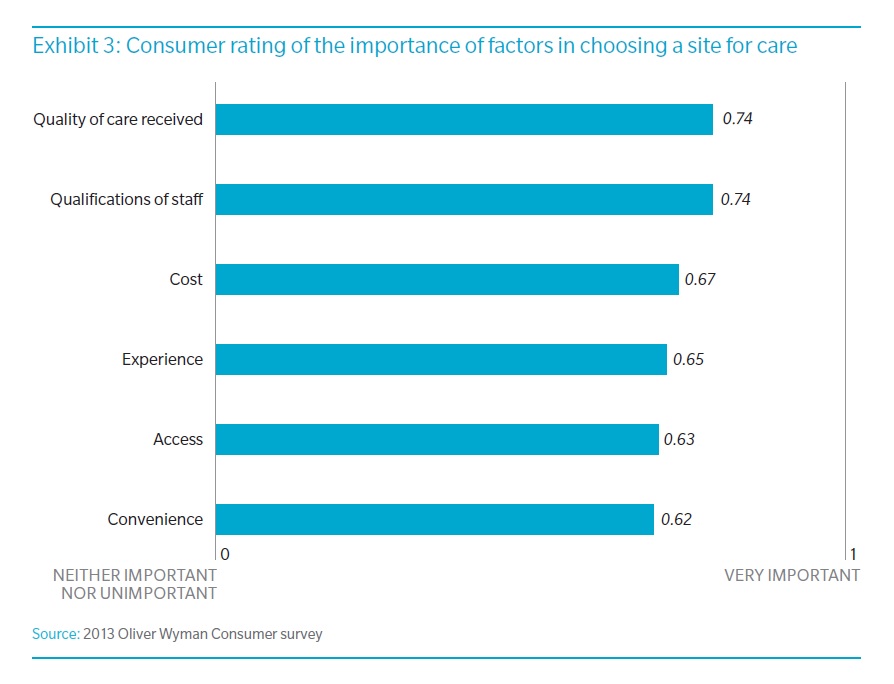By mid-year 2014 approximately $2.3 billion of venture funding for digital health had been placed, surpassing the total investment made in all of 2013. This is yet another statistic that demonstrates an evolving healthcare ecosystem where reform is creating disruptive forces that alter the impact and importance of the players involved.
With changing business practices and a greater emphasis on consumerism, healthcare organizations are looking across their enterprises for answers. Facilities are not escaping the drag net and we continue to see evolving trends that will define the market for real estate and facilities services in 2015 and beyond. The three areas of change we will explore are new products, delivery models, and relationships.
NEW PRODUCTS
With consumers funding more and more of their healthcare services out of pocket, they are becoming more selective in who they seek healthcare services from. In a 2013 survey of healthcare consumers conducted by Oliver Wyman, consumers responded that their top reason for choosing a particular healthcare services location was the quality of care received. Consumers will be focused on every interaction they have with a healthcare provider to rate quality of care from setting up their appointments to the results they experience during and after their visit. The concept of “service” will become a focus of providers that will be successful in 2015 and beyond.
As healthcare organizations plan new facilities and evaluate their overall real estate portfolio, they will continue to look towards facilities that support a first class experience. Not only will they be concerned with the consumer experience, but employee satisfaction will also play a major role. The continued growth of retail care in a healthcare organizations real estate portfolio will continue to be a focus in 2015 and beyond. We will likely see more unique mixed-use projects that carry the live, work and play theme as healthcare focuses on prevention rather than episodic care.
DELIVERY MODELS
As healthcare organizations change their business practices across the enterprise, they are also looking to change the way facilities are delivered and managed. Integrated project delivery models are being requested on a more frequent basis. Many companies that used to market to healthcare organizations as design-build firms have altered their messaging to include the term “integrated.” Healthcare organizations continue to adopt performance improvement models such as Lean to improve their business and integrated project delivery is a natural fit for that culture.
The shift towards an integrated model of delivery is not just project by project based but portfolio based as well.
Healthcare organizations are beginning to see the value of reviewing their entire portfolio and determining the highest and best use for each asset with an understanding of the role it can play in a highly distributed service model. This has increased the demand for strategic real estate planning services that are more holistic than we have seen in the past.
There is a growing desire to develop key performance indicators (KPIs) that take into account clinical outcomes, service line financial performance, building performance and space utilization among other points. Analytical models will be developed in the future that provide an accepted rating system and allow healthcare organizations to measure the true performance of their real estate assets across the ecosystem.
RELATIONSHIPS
New products and an emphasis on new delivery models create new relationships. As healthcare organizations seek more opportunities to save in the delivery and care of facilities, they continue to demand more from group purchasing organizations (GPOs). In the past, GPOs have been focused on medical equipment and other essential supplies necessary to deliver care.
As healthcare organizations expand their net for savings opportunities, they are requesting volume pricing on construction materials, building systems and service contracts. With a limited amount of GPO coverage within this sector, healthcare organizations are exploring direct relationships with key suppliers in an effort to drive prices and increase schedule efficiencies by having more direct control over supply chains.
With an emphasis on ambulatory and retail building products, speed to market becomes more important and, therefore, better predictability with respect to schedule and budget. This has created a demand for roll-out strategies that can deliver portfolios rather than single projects. Healthcare organizations are seeking qualified integrated teams to deliver a solution including the ability to finance, design, build and maintain.
The relationship model continues to shift to a group of preferred providers that are in tune with the organization’s overall strategy and understand their culture and decision making style. In an industry with plenty of chaos, seeking solutions that provide a more predictable outcome will be a focus for healthcare organizations in 2015 and beyond.
CONCLUSION
Healthcare continues to shift toward Madison Avenue and Silicon Valley as it revamps business practices to focus on consumerism and efficiency. Not only does this impact the actual delivery of services, but it continues to have a large effect on the location and type of facility in which those services are delivered. In the next year, expect to see the following:
• Product. A continued emphasis on Ambulatory and Retail facilities and increased development of population health management tools such as wellness centers, adult daycare centers, and virtual medicine hubs.
• Delivery. Continued alignment in the delivery and care of facilities with a culture of improvement. An increase in integrated project delivery and risk sharing models based on short and long term outcomes. Development of holistic analytical models for evaluating portfolio performance.
• Relationships. A change in the relationship between Suppliers, GPOs and healthcare organizations that provides more direct access to innovations without delays and surcharges.
For service providers in the real estate, design and construction industry it will be important to understand how exactly how the healthcare industry is evolving. With shifting payment models and an emphasis on value creation, healthcare organizations will be open to partners that are able to contribute to achieving their strategic goals and not just deliver on a transaction.
The more a firm can demonstrate a predictable outcome that delivers results, the quicker they will become a trusted and preferred partner well into the future.
Related Stories
Codes and Standards | Apr 8, 2024
Boston’s plans to hold back rising seawater stall amid real estate slowdown
Boston has placed significant aspects of its plan to protect the city from rising sea levels on the actions of private developers. Amid a post-Covid commercial development slump, though, efforts to build protective infrastructure have stalled.
Sustainability | Apr 8, 2024
3 sustainable design decisions to make early
In her experience as an architect, Megan Valentine AIA, LEED AP, NCARB, WELL AP, Fitwel, Director of Sustainability, KTGY has found three impactful sustainable design decisions: site selection, massing and orientation, and proper window-to-wall ratios.
Brick and Masonry | Apr 4, 2024
Best in brick buildings: 9 projects take top honors in the Brick in Architecture Awards
The Ace Hotel Toronto, designed by Shim-Sutcliffe Architects, and the TCU Music Center by Bora Architecture & Interiors are among nine "Best in Class" winners and 44 overall winners in the Brick Industry Association's 2023 Brick in Architecture Awards.
Retail Centers | Apr 4, 2024
Retail design trends: Consumers are looking for wellness in where they shop
Consumers are making lifestyle choices with wellness in mind, which ignites in them a feeling of purpose and a sense of motivation. That’s the conclusion that the architecture and design firm MG2 draws from a survey of 1,182 U.S. adult consumers the firm conducted last December about retail design and what consumers want in healthier shopping experiences.
Healthcare Facilities | Apr 3, 2024
Foster + Partners, CannonDesign unveil design for Mayo Clinic campus expansion
A redesign of the Mayo Clinic’s downtown campus in Rochester, Minn., centers around two new clinical high-rise buildings. The two nine-story structures will reach a height of 221 feet, with the potential to expand to 420 feet.
Sports and Recreational Facilities | Apr 2, 2024
How university rec centers are evolving to support wellbeing
In a LinkedIn Live, Recreation & Wellbeing’s Sadat Khan and Abby Diehl joined HOK architect Emily Ostertag to discuss the growing trend to design and program rec centers to support mental wellbeing and holistic health.
Architects | Apr 2, 2024
AE Works announces strategic acquisition of WTW Architects
AE Works, an award-winning building design and consulting firm is excited to announce that WTW Architects, a national leader in higher education design, has joined the firm.
Office Buildings | Apr 2, 2024
SOM designs pleated façade for Star River Headquarters for optimal daylighting and views
In Guangzhou, China, Skidmore, Owings & Merrill (SOM) has designed the recently completed Star River Headquarters to minimize embodied carbon, reduce energy consumption, and create a healthy work environment. The 48-story tower is located in the business district on Guangzhou’s Pazhou Island.
K-12 Schools | Apr 1, 2024
High school includes YMCA to share facilities and connect with the broader community
In Omaha, Neb., a public high school and a YMCA come together in one facility, connecting the school with the broader community. The 285,000-sf Westview High School, programmed and designed by the team of Perkins&Will and architect of record BCDM Architects, has its own athletic facilities but shares a pool, weight room, and more with the 30,000-sf YMCA.
Market Data | Apr 1, 2024
Nonresidential construction spending dips 1.0% in February, reaches $1.179 trillion
National nonresidential construction spending declined 1.0% in February, according to an Associated Builders and Contractors analysis of data published today by the U.S. Census Bureau. On a seasonally adjusted annualized basis, nonresidential spending totaled $1.179 trillion.


















